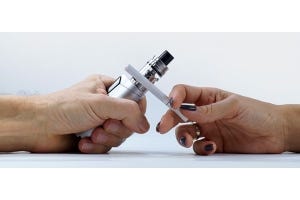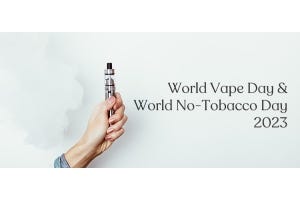Exclusive ECF Interview: Dr Konstantinos Farsalinos
If you’re expressing your opinion about
e-cigarettes in public, you should know
what you’re talking about…
Dr Konstantinos Farsalinos is a Greek cardiovascular specialist who in recent years has become increasingly high-profile internationally on account of his groundbreaking clinical research into e-cigarettes and the effects of their use. He spoke to ECF as he embarked on a study into the ingredients of e-liquids that was made possible through crowdfunding by vapers and e-cigarette companies. We talked to him about his work, the future of vaping and how not all the reputed experts are telling the truth.
E-Cigarette Forum: Your day job is in cardiovascular research at a Belgian hospital, so what led you from that to focus on e-cigarette research? Some might struggle to see the link.
Dr Farsalinos: It came up by coincidence. I’d just finished a study detecting cardiac dysfunction in smokers, when two friends sent me a picture message showing them with their new e-cigarettes. My first reaction was that they’d wasted their money on a gimmick; if they really wanted to quit smoking I’d prescribe them with medication. But they stuck with it and continued sending me pictures of them vaping. After a while I saw that it really was working for them. It struck me that this was something that needed to be looked at properly, at a scientific level, so I set out to conduct some research into the potential benefits. I discovered a Greek e-cigarette forum and that’s where I found the volunteers for my first clinical study into e-cigarettes.
A large number of people in the medical field seem to have taken an automatic stance against e-cigarettes. Does it feel like you and your team are treading a lonely path?
Last year, I felt quite lonely. There were just a handful of us conducting e-cigarette research and we were probably considered crazy by most of the others in our field. But we are growing; e-cigarettes get more backing every day. In the last few months we’ve had more and more people from the scientific and medical fields support us
Why are those people coming around now?
There’s still not enough data from research yet, but there is far more than what was available in previous years. During that time the public has really taken to e-cigarettes too, despite the negative publicity. I think these factors have convinced people to look closer. I believe most of the people expressing negative opinion about e-cigarettes don’t really have any deep knowledge about the products. If you’re expressing your opinion about e-cigarettes in public you should know what you’re talking about, because the things we say as scientists influence a lot of people. I know a lot of smokers who were put off right at the point of trying an e-cigarette. Even worse, I’ve seen a lot of vapers go back to smoking after hearing scientists discuss the potential hazards of e-cigarettes - the problem is that they often forget to mention the dangers of smoking.
There’s a depressing irony at play there.
Nobody is expecting e-cigarettes to be an absolutely safe and healthy habit though…but they don’t have to be.
That’s interesting, because from what I see in the press some people won’t be happy with vaping unless it’s 100% risk-free.
Do you know any medication that has no side effects? For example: Paracetamol is used the world over, but it’s the number one cause behind people ending their own lives. If you take just 10 tablets at once, you can develop acute liver necrosis. It’s important to be clear that we’re not saying e-cigarettes are a good thing overall. They’re a good thing for a smoker, they’re not a good thing for everyone else. I wouldn’t suggest non-smokers take up vaping. But for smokers, considering the devastating effects of tobacco, there is no comparison. It’s a complete revolution in tobacco harm reduction. Although the ideal thing would be for vaping to be just a bridge to quitting smoking, where at the end you stop vaping too. The biggest difference between smoking and vaping is that tobacco cigarettes were made to turn non-smokers into smokers. Since the beginning, e-cigarettes have been marketed for smokers to become vapers, not for non-smokers to become vapers. E-cigarette companies don’t need to target youngsters or non-smokers and that’s the big difference that Tobacco Control refuses to accept.
Yet the press often runs stories about children vaping, or how vaping is considered cool amongst their peers, just like smoking. Is there any truth in that?
We have data from the USA and the UK on this, but the headlines don’t match the results once you look at them properly – the best example being the latest CDC study. Some very vocal people at the CDC are making out that we are witnessing a new nicotine epidemic from e-cigarettes. But they weren’t asking these young people if they were regular users. The results were based on the question ‘have you tried an e-cigarette in the last 30 days?’ According to the CDC you’re a user if you’ve had even one puff in the last 30 days. Yet if you took the number of young people who were not smokers but had tried an e-cigarette over the last 30 days, the number was just 0.5%. They presented that result as a problem, which it is not. According to common sense, 0.5% is almost non-existent. Others have exaggerated the results even more. I won’t name anyone simply because I don’t want to give them the oxygen of publicity, but there are professors of medicine in the United States whose statements on this make them look ridiculous. Unfortunately they’re using the official websites of universities to do it, so they’re ridiculing the universities too. It’s something I just can’t understand, I would never disgrace myself in that way. You only need to check the numbers to see that the public statements they make after these studies are nonsense.
Have any of your own studies been misrepresented?
The EU has certainly been guilty of isolating sentences in my studies and presenting them in a different context. I can’t blame the regulators for not being scientists or experts in everything they legislate, of course. But at the least they should read the detailed documents and ask for clarification and advice when they need it. Often they don’t do this. They just take a sentence that fits their agenda and use it to apply regulations that affect millions of people. I wasn’t surprised by the EU regulators’ reaction to e-cigarettes. The problem for them is that they acted too late because there are so many millions of users in Europe that they can’t ignore them. And that’s why they can’t ban them or apply medicinal regulations. If they’d tried to do it three years ago, no one would have paid attention and there would have been little reaction. But they came too late. That’s good for the e-cigarette and good for smokers. The current EU regulation has significant problems of course, particularly around nicotine limits. The current limit is very low. I’ve done two studies on nicotine absorption from e-cigarettes, including the only study that used a third generation device at 9w with a clearomizer. Although we used experienced vapers, the levels of absorption were around one third of that from tobacco – you’d need to vape for 35 minutes to get plasma nicotine levels similar to smoking one tobacco cigarette in five minutes. This shows that e-cigarettes are inefficient at providing nicotine at the same level, especially at the same speed, as tobacco cigarettes.
If they were more efficient, would they be more effective as a smoking cessation device?
Of course, the more you simulate the nicotine delivery from smoking the better it will be. There are a lot of things to be done to improve e-cigarettes. But having an upper limit of 20mg is a big step back.
That’s quite a controversial point to make though, that e-cigarettes should be stronger.
It is, but there are other issues too. The latest studies show that nicotine needs some other chemicals present in tobacco to be really addictive. It’s not as addictive on its own as we thought. I’m not saying that it’s not addictive at all of course, but it seems that other alkaloids largely potentiate the addictive properties of nicotine. These are not present in e-cigarettes. I doubt that a non-smoker could be addicted to e-cigarettes. I’m not saying it’s impossible, but I think it’s very difficult.
How much of your life does your work around e-cigarettes take up?
The majority of it. In order to do research you have to be a little bit crazy, and you have to really love research. It’s not just a profession. But it’s not just about performing the actual research, a lot goes into a study, and a single study is a very difficult thing to do. First of all you have to plan the research and design the protocols around it. Then you have to find the funds. It also needs to be approved by the hospital’s ethics committee. Once those stages are complete you have to find volunteers. So there’s a lot to be done before you even start.
How many vaping studies have you done now?
So far I’ve published seven, with a further three accepted and awaiting publication. I have several more protocols ready on my desk, already approved by the ethics committee, including one to look at detecting metabolites of carcinogenic substances in smokers compared to vapers. They’re just waiting for someone to provide the money to do them. If I had the money I would start tomorrow.
How do you usually fund your studies?
Some of the studies I’ve done that haven’t required expenses, such as hospital or lab fees, were performed for free. One example is the Vaping Topography Study where my team and I worked without being paid during our free time, even during weekends. I can’t even count the number of hours we put in video-recording people vaping and analysing the results with specialized software. But even with my team’s willingness to work for free we just can’t undertake expensive clinical studies. For example when we did the Coronary Flow Velocity Study the hospital where the study was performed asked for €240 per person, per examination. The study involved more than 80 volunteer participants, each of whom required two examinations. That’s a lot of money, and that’s just the hospital fee. Studies often need a number of people working on them. It’s impossible for me to administer an intravenous injection and perform a cardiogram at the same time. There has to be someone else helping me, usually more than one.
Decades ago smoking was promoted as being healthy, because of research we know now that the complete opposite is true. Do you think that people are scared of admitting vaping could be less dangerous than smoking in case they’re proved wrong at some point in years to come and held responsible?
That’s why my main statements are that e-cigarettes, according to current research, are by far less harmful than tobacco. I’m not saying it’s safe, I’m not saying it’s a healthy habit so that everyone should go ahead and do it. I’m just comparing it with the effects of tobacco, knowing what’s in tobacco smoke. Of course, there are many things that we need to know on a laboratory level, from the effects of various materials on the release of heavy metals and toxins in the vapour to analysing the consequences of chemicals released through high-wattage e-cigarette use. There are currently endless possibilities for research, we have many protocols prepared, but funding is missing. So we have to be cautious with e-cigarettes. For example we have no idea what’s happening when we inhale flavours. Most of those are approved for use in food but have not been tested for inhalation.
That brings us to your current study regarding potentially harmful ingredients in liquids. Can you elaborate on that?
I started doing this study based on one-or-two samples in which we found some chemicals that shouldn’t have been there. There’s a lot of anxiety around this, which I understand of course, and people ask me about it every day. But we have to define the problem first, which is what my team and I are doing now. If we talk about this without defining the problem we run the risk of creating ‘news’ that isn’t accurate. We’re testing around 160 liquids from all over the world. We want to see if a problem exists on a global scale, and to what extent. When we have our findings we’ll announce how many liquids were affected and what we found within them. But we’ll also present our proposal for a solution, because just defining the problem means nothing.
What’s the main issue right now as you see it?
There’s currently no widespread testing of products as they’re made, this is a problem. Another problem is the lack of knowledge held by companies that manufacture and sell vape juice. This industry has developed form small and medium-sized companies; there is no big industry (until recently). They don’t know what to test, even if they want to invest their money on it. So they’re “trapped”. I’ve seen some companies trying to do testing, but it’s been useless, providing almost zero useful information. They’re searching over the Internet, asking chemical labs what they should do. But most scientists, even those who are very respected experts in their field, lack the required knowledge if they haven’t worked on e-cigarettes specifically. They’re a very complicated new product, we’ve never seen anything of this complexity before – it’s an integration of chemistry, technology, electronics and physics. It’s so complicated that I’ve seen experienced labs making huge methodological mistakes when we gave them an e-cigarette to test. It’s very important to know what you’re doing, because at a laboratory level it’s extremely easy to misuse them and produce useless unrealistic results. If the tests don’t represent the way the product is used by vapers, then what is the point?
One of the arguments you hear from smaller companies is that they couldn’t afford to test their own products and survive as a business.
Well, in reality only producers need be responsible for testing. Retailers don’t have to do any testing; it’s not logical or realistic, they should only be responsible for making sure that the products they sell have been properly tested. The issue there is that no one is asking for any tests. The onus is on the producers, and it’s not enough for them to say that they test products, they have to release the results to prove it. Otherwise, they could say whatever they want. I’m confident that the industry will be responsible enough to react and solve any problems as soon as possible. If producers start releasing results it would make a lot of marketing sense. They could show the public that the product they sell is safe to inhale, and their competitors would have to do the same to remain in the market. Regulation will eventually require that tests on liquids are mandatory and if advertising is prohibited, as dictated by the regulation of the European Union, I think the only way of marketing your products will be through testing, so the more extensive the testing you do the bigger marketing advantage you have. You won’t be able to sponsor events or advertise on news media, but you’ll get customers by showing that your products are more effective and less harmful than the competition.
What part do vapers, play in this?
Vapers should apply pressure to companies for tests. Vapers should base their choices on test results, not just how the products look or taste, because really it’s more important for them in the long run. It hasn’t worked like that up until now, but eventually I think it will.
The crowdfunding campaign on Indiegogo attracted a lot of larger donations from e-cigarette companies. Was that something you had planned upon?
I was surprised, to tell you the truth. I was expecting most of the money would come from vapers. But I’m glad I was wrong, because I hadn’t had much of a positive reaction from e-cigarette companies until then. Usually you find one sponsor for the whole project, research is not normally paid for by crowdfunding campaigns. In fact it’s quite rare and it’s certainly something I haven’t done before. But because it’s been so successful I will do it again.
Do you suspect that some of the companies that funded you might be expecting to see a result in their favor?
Potentially, but that’s not the way we work. We bought the liquids from the market ourselves, in most, if not all, of the cases anonymously, so no one knows which samples we have collected. In the end, it’s of no benefit to those companies to only discuss the positive aspects of vaping.
Is there specific research that you would like to see taking place right now if funding and resources were unlimited?
What we need is long-term follow-up studies, with thousands of participants. But these studies will have to start now and evolve over several years. Smoking has long-term adverse effects; no smoker dies after one year of smoking, that’s why we need to be patient. Also, vapers are generally of a younger age, in their thirties or forties, so the risk of developing disease is small. So to see statistically significant results on an epidemiological level you need to see thousands of them, followed up for years. That research is going to be very, very important.
Find out more about Dr Farsalinos’ work at ecigarette-research.com











